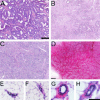Stromal regulation of neoplastic development: age-dependent normalization of neoplastic mammary cells by mammary stroma
- PMID: 16251424
- PMCID: PMC1603788
- DOI: 10.1016/S0002-9440(10)61227-8
Stromal regulation of neoplastic development: age-dependent normalization of neoplastic mammary cells by mammary stroma
Abstract
There is mounting evidence that the stroma plays a crucial role in mammary gland carcinogenesis. Here, we report that mammary gland stroma from mature and multiparous rats prevents neoplastic development and encourages normal ductal growth of grafted epithelial cancer cells. Fifty thousand epithelial cancer cells were injected into the cleared fat pads of virgin hosts at 24, 52, 80, and 150 days of age and of hosts that had undergone two cycles of pregnancy, lactation, and involution. Six months after inoculation, tumor incidence was 75%, 100%, 50%, and 18.2% in 24-, 52-, 80-, and 150-day-old virgin rats, respectively, and 0% in the twice-parous animals. Most remarkably, these neoplastic cells appeared to form normal ducts in all hosts-Ha-ras-1 mutation served as a marker to identify the tumor origin of the outgrowths. The tumor development pattern suggests a parallel to the phenomenon of age- and reproductive state-dependent susceptibility and resistance to chemical carcinogens. As susceptibility to carcinogenesis decreases, the ability of the stroma to reprogram neoplastic epithelial cells increases. Thus, the neoplastic phenotype is context-dependent, and it therefore offers the intriguing possibility that the process of carcinogenesis is amenable to normalization or cure once the mechanisms of stroma-mediated normalization are elucidated and manipulated.
Figures




Similar articles
-
The stroma as a crucial target in rat mammary gland carcinogenesis.J Cell Sci. 2004 Mar 15;117(Pt 8):1495-502. doi: 10.1242/jcs.01000. Epub 2004 Mar 2. J Cell Sci. 2004. PMID: 14996910
-
Influence of differentiation and cell kinetics on the susceptibility of the rat mammary gland to carcinogenesis.Cancer Res. 1980 Aug;40(8 Pt 1):2677-87. Cancer Res. 1980. PMID: 7388818
-
Watch thy neighbor: cancer is a communal affair.J Cell Sci. 2004 Mar 15;117(Pt 8):1287-90. doi: 10.1242/jcs.01137. J Cell Sci. 2004. PMID: 15020668
-
Molecular insights into breast cancer from transgenic mouse models.Bioessays. 1991 Nov;13(11):591-6. doi: 10.1002/bies.950131109. Bioessays. 1991. PMID: 1663341 Review.
-
Hormone/growth factor interactions mediating epithelial/stromal communication in mammary gland development and carcinogenesis.J Steroid Biochem Mol Biol. 2002 Feb;80(2):213-30. doi: 10.1016/s0960-0760(01)00188-1. J Steroid Biochem Mol Biol. 2002. PMID: 11897505 Review.
Cited by
-
Human adipose tissue from normal and tumoral breast regulates the behavior of mammary epithelial cells.Clin Transl Oncol. 2013 Feb;15(2):124-31. doi: 10.1007/s12094-012-0896-x. Epub 2012 Jul 19. Clin Transl Oncol. 2013. PMID: 22855180
-
Adverse outcome pathways for ionizing radiation and breast cancer involve direct and indirect DNA damage, oxidative stress, inflammation, genomic instability, and interaction with hormonal regulation of the breast.Arch Toxicol. 2020 May;94(5):1511-1549. doi: 10.1007/s00204-020-02752-z. Epub 2020 May 13. Arch Toxicol. 2020. PMID: 32399610 Free PMC article. Review.
-
Histological analysis of low dose NMU effects in the rat mammary gland.BMC Cancer. 2009 Aug 3;9:267. doi: 10.1186/1471-2407-9-267. BMC Cancer. 2009. PMID: 19650921 Free PMC article.
-
Neoplasia as development gone awry: the role of endocrine disruptors.Int J Androl. 2008 Apr;31(2):288-93. doi: 10.1111/j.1365-2605.2007.00834.x. Epub 2007 Oct 31. Int J Androl. 2008. PMID: 17971158 Free PMC article. Review.
-
The end of the genetic paradigm of cancer.PLoS Biol. 2025 Mar 18;23(3):e3003052. doi: 10.1371/journal.pbio.3003052. eCollection 2025 Mar. PLoS Biol. 2025. PMID: 40100793 Free PMC article. Review.
References
-
- Gilbert SF. Proximate tissue interactions: secondary induction. Sunderland: Sinauer Associates, Inc.,; Developmental Biology. (ed 3) 1991:pp 570–606.
-
- Shekhar MP, Werdell J, Santner SJ, Pauley RJ, Tait L. Breast stroma plays a dominant regulatory role in breast epithelial growth and differentiation: implications for tumor development and progression. Cancer Res. 2001;61:1320–1326. - PubMed
-
- Cunha GR, Hayward SW, Wang YZ, Ricke WA. Role of the stromal microenvironment in carcinogenesis of the prostate. Int J Cancer. 2003;107:1–10. - PubMed
-
- Cunha GR, Bigsby RM, Cooke PS, Sugimura Y. Stromal-epithelial interactions in adult organs. Cell Differ. 1985;17:137–148. - PubMed
-
- Potter J. Morphostats: a missing concept in cancer biology. Cancer Epidemiol Biomarkers Prev. 2001;10:167–170. - PubMed
Publication types
MeSH terms
LinkOut - more resources
Full Text Sources
Other Literature Sources
Research Materials

